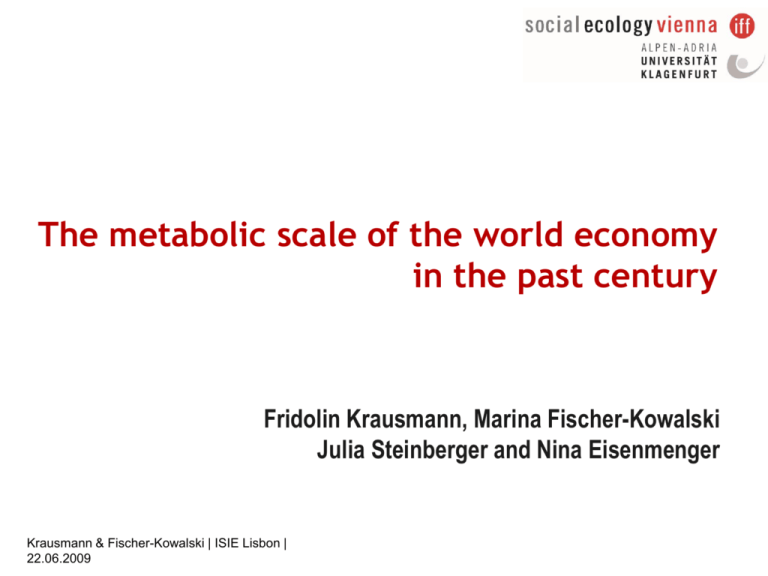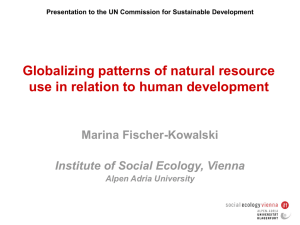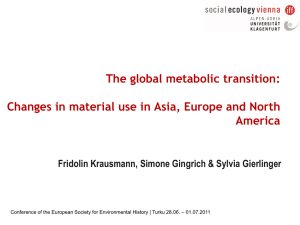PowerPoint-Präsentation
advertisement

The metabolic scale of the world economy in the past century Fridolin Krausmann, Marina Fischer-Kowalski Julia Steinberger and Nina Eisenmenger Krausmann & Fischer-Kowalski | ISIE Lisbon | 22.06.2009 Overview • Global metabolic scale • Metabolic rates • Global convergence scenarios • Resource productivity Krausmann & Fischer-Kowalski | ISIE Lisbon | 22.06.2009 Global materials extraction = use (DMC) 1900 to 2005 60 Construction minerals Ores and industrial minerals Fossil energy carriers Biomass [billion tons] 40 20 Krausmann & Fischer-Kowalski | ISIE Lisbon | 22.06.2009 2005 2000 1995 1990 1985 1980 1975 1970 1965 1960 1955 1950 1945 1940 1935 1930 1925 1920 1915 1910 1905 1900 0 Global material extraction database Material type Content Source Biomass 165 primary crops incl. used crop residues (<50 crops) Roughage and grazed biomass (12 items) Wood harvest FAO and predecessors; used crop residues (model); grazed biomass (model); wood harvest (FAO, various estimates) Fossil energy carriers Hard and soft coal, petroleum, natural gas, peat Podobnik 1995, United Nations 1950, IEA 2007 Ores 44 ores (gross ore) Metal content: USGS 2008 Gross ores: estimate Non metallic minerals 33 non-metallic minerals USGS 2008 Construction minerals Limestone for cement production, sand and gravel for construction Conservative estimate; based on cement production; concrete production and asphalt production Krausmann & Fischer-Kowalski | ISIE Lisbon | 22.06.2009 Metabolic scale: Global materials use 1900 to 2005 60 Construction minerals Ores and industrial minerals Fossil energy carriers Biomass [billion tons] 40 20 Krausmann & Fischer-Kowalski | ISIE Lisbon | 22.06.2009 2005 2000 1995 1990 1985 1980 1975 1970 1965 1960 1955 1950 1945 1940 1935 1930 1925 1920 1915 1910 1905 1900 0 Metabolic scale: Global materials use 1900 to 2005 25 Biomass Fossil energy carriers 20 Ores and industrial minerals Construction minerals [billion tons] 15 10 5 Krausmann & Fischer-Kowalski | ISIE Lisbon | 22.06.2009 2005 2000 1995 1990 1985 1980 1975 1970 1965 1960 1955 1950 1945 1940 1935 1930 1925 1920 1915 1910 1905 1900 - Periods of growth: Average annual growth rates (DMC, GDP, population) [average annual growth rate] 5,0% 1900-1945 1945-1973 1973-2000 2000-2005 4,0% 3,0% 2,0% 1,0% 0,0% DMC Krausmann & Fischer-Kowalski | ISIE Lisbon | 22.06.2009 GDP Population Metabolic scale Definition: metabolic scale is the size of the overall annual material (DMC) or primary energy input (TPES, DEC) of a socio-economic system, measured according to established standards of MEFA analysis. The metabolic scale of the world economy has been increasing by one order of magnitude during the last century: – Materials use: From 7 billion tons to over 60 bio t (DMC, all materials). – Energy use: From 44 EJ primary energy to 480 EJ (TPES, commercial energy only). Krausmann & Fischer-Kowalski | ISIE Lisbon | 22.06.2009 Metabolic rate Definition: Metabolic rate is the metabolic scale of a socio-economic system divided by its population number = annual material / energy use per capita It represents the biophysical burden associated to an average individual The global metabolic rate: • Moderate growth from 1900 to 1945 (0.2%); • Rapid growth from 1945 to 1973 (1.6%); • Stabilization from 1973 to 2000 (0.6%) despite substantial economic growth; 8t/cap (DMC) and 60 GJ/cap (TPES). • Since 2000: a new phase of growth (3.7%) can be observed. Krausmann & Fischer-Kowalski | ISIE Lisbon | 22.06.2009 Metabolic rates: Material and energy use per capita 10,0 100,0 TPES/cap (primary yaxis) 80,0 DMC/cap (secondary yaxis) 8,0 60,0 6,0 40,0 4,0 Energy 2,0 20,0 - 1900 1905 1910 1915 1920 1925 1930 1935 1940 1945 1950 1955 1960 1965 1970 1975 1980 1985 1990 1995 2000 2005 - Krausmann & Fischer-Kowalski | ISIE Lisbon | 22.06.2009 DMC [t/cap/yr] TPES [GJ/cap/yr] Materials National trends: metabolic scale (DMC) 60 9 Global Construction minerals USA: 15% of global Minerals Ores Ores and industrial minerals Fossil fuels Fossil energy carriers Biomass Biomass 40 2005 2000 1995 1990 1985 1980 1975 1970 1965 1960 1955 1950 1945 1940 1935 1930 1925 1920 1915 1910 1900 2005 2000 1995 1990 1985 1980 1975 1970 1965 1960 1955 1950 1945 1940 1935 1930 1925 1920 1915 0 1910 0 1905 3 1900 20 1905 [billion tons] [billion tons] 6 3 Brazil: 4% of global Minerals 5 Ores Construction minerals Fossil fuels Ores and industrial minerals Biomass India: 8% of global Fossil fuels 4 Biomass [billion tons] [billion tons] 2 3 2 Sources: USA: Gierlinger 2009 Brazil: Mayer 2009 India: Lanz 2009 1 1 0 Krausmann & Fischer-Kowalski | ISIE Lisbon | 22.06.2009 2000 1995 1990 1985 1980 1975 1970 1965 1960 1955 1950 1945 1940 1935 1930 1925 1920 1915 1910 1905 1900 2005 2000 1995 1990 1985 1980 1975 1970 1965 1960 1955 1950 1945 1940 1935 1930 1925 1920 1915 1910 1905 1900 0 National trends: metabolic rates 30,0 30 Construction minerals Minerals Global Ores and industrial minerals USA Ores Fossil energy carriers Fossil fuels Biomass Biomass 20 2005 2000 1995 1990 1985 1980 1975 1970 1965 1960 1955 1950 1945 1940 1935 1930 1925 1920 1915 1910 1900 2005 2000 1995 1990 1985 1980 1975 1970 1965 1960 1955 1950 1945 1940 1935 1930 1925 1920 1915 0 1910 1905 10 1900 10,0 1905 [t/cap/yr] [t/cap/yr] 20,0 30 30 Construction minerals Minerals Brazil Ores India Ores and industrial minerals Fossil fuels Fossil fuels Biomass Biomass 20 2000 1995 1990 1985 1980 1975 1970 1965 1960 1955 1950 1945 1940 1935 1930 1925 1920 1915 1910 Krausmann & Fischer-Kowalski | ISIE Lisbon | 22.06.2009 Sources: USA: Gierlinger 2009 Brazil: Mayer 2009 India: Lanz 2009 1905 2005 2000 1995 1990 1985 1980 1975 1970 1965 1960 1955 1950 1945 1940 1935 1930 1925 1920 1915 0 1910 0 1905 10 1900 10 1900 [t/cap/yr] [t/cap/yr] 20 Metabolic rate vs. income (GDP/cap): R2 = 0.64 N = 175 countries Year 2000 Krausmann & Fischer-Kowalski | ISIE Lisbon | 22.06.2009 Metabolic rates by development status and population density DMC t/cap in yr 2000 25 Construction minerals Ores and industrial minerals 20 Fossil fuels Biomass 15 10 5 - Share of world population Pop density High density industrial Low density industrial High density developing Low density developing (NW) 13% 6% 62% 6% 123 12 140 19 Krausmann & Fischer-Kowalski | ISIE Lisbon | 22.06.2009 Scenario assumptions (all : relation between high density/low density countries remains unchanged; population growth by UN projection) 1. Baseline 2000 scenario 2. Freeze and catching up: industrial countries maintain their metabolic rates of the year 2000, developing countries catch up to same rates 3. Factor 2 and catching up: industrial countries reduce their metabolic rates by factor 2, developing countries catch up 4. Freeze global DMC: global resource consumption by the year 2000 remains constant by 2050, industrial and developing countries settle for identical metabolic rates Krausmann & Fischer-Kowalski | ISIE Lisbon | 22.06.2009 Global convergence scenarios Global metabolic rates in t/cap 16 Construction minerals Ores and industrial minerals Fossil fuels 12 160 Biomass Global metabolic scales in billion tonnes 8 120 4 80 0 Baseline 2000 Freeze & catching up Factor 2 & catching up Freeze global DMC 40 0 Baseline 2000 Krausmann & Fischer-Kowalski | ISIE Lisbon | 22.06.2009 Freeze & catching up Factor 2 & catching up Freeze global DMC Global convergence scenarios Global metabolic rates in t/cap 18 Baseline 2000 Global metabolic scales in billion tonnes Freeze & catching up 150 Freeze global DMC Baseline 2000 12 Freeze & catching up Factor 2 & catching up Freeze global DMC metabolic scale [Gt] metabolic rate [t/cap/yr] Factor 2 & catching up 6 100 50 2050 2040 2030 2020 2010 2000 1990 1980 1970 1960 1950 1940 1930 1920 1910 1900 - Krausmann & Fischer-Kowalski | ISIE Lisbon | 22.06.2009 2050 2040 2030 2020 2010 2000 1990 1980 1970 1960 1950 1940 1930 1920 1910 1900 - Resource productivity: 100 1,0 75 0,8 50 0,5 25 0,3 Energy (primary y-axis) Materials (secondary y-axis) 1900 1905 1910 1915 1920 1925 1930 1935 1940 1945 1950 1955 1960 1965 1970 1975 1980 1985 1990 1995 2000 2005 - Krausmann & Fischer-Kowalski | ISIE Lisbon | 22.06.2009 Material iproductivity [$ GDP/kg DMC] Energy productivity [$ GDP/GJ TPES] GDP per unit of materials and energy input Resource productivity: GDP per unit of materials input (biomass/minerals) 2,5 Material productivity [$ GDP/kg DMC] Biomass 2,0 1,5 Minerals 1,0 0,5 Biomass Minerals 1900 1905 1910 1915 1920 1925 1930 1935 1940 1945 1950 1955 1960 1965 1970 1975 1980 1985 1990 1995 2000 2005 - Krausmann & Fischer-Kowalski | ISIE Lisbon | 22.06.2009 Thank you for your attention! • Data download: http://www.uni-klu.ac.at/socec/inhalt/1088.htm • Publications: – Krausmann, F., Gingrich, S., Eisenmenger, N., Erb, K.H., Haberl, H., FischerKowalski, M. 2009. Growth in global materials use, GDP and population during the 20th century, Ecological Economics (in press). – Krausmann, F., M. Fischer-Kowalski, H. Schandl, and N. Eisenmenger 2008. The global socio-metabolic transition: past and present metabolic profiles and their future trajectories. Journal of Industrial Ecology 12(5/6), 637-656. Krausmann & Fischer-Kowalski | ISIE Lisbon | 22.06.2009






